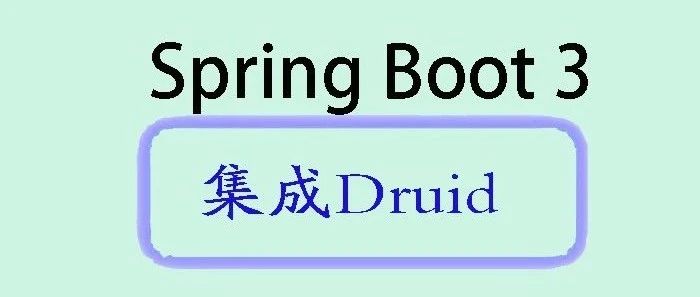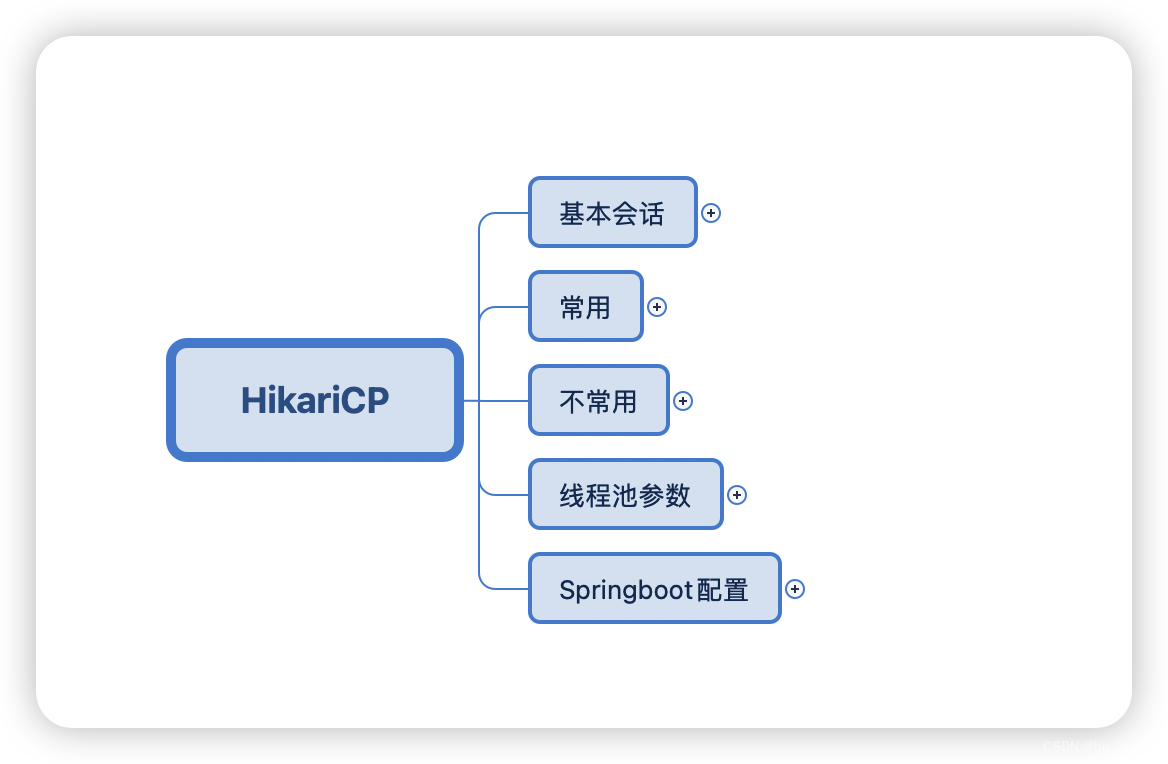SpringBoot 报 No operations allowed after connection closed 异常解决办法
SpringBoot 报 No operations allowed after connection closed 异常解决办法
1.1 异常原因
MySQL 5.0 以后针对超长时间数据库连接做了一个处理,即一个数据库连接在无任何操作情况下过了 8 个小时后(MySQL 服务器默认的超时时间是 8 小时),MySQL 会自动把这个连接关闭。在数据库连接池中的 connections 如果空闲超过 8 小时,MySQL 将其断开,而数据库连接池并不知道该 connection 已经失效,这个时候你请求数据库链接,连接池会将失效的 connection 给你,so~,SpringBoot 温柔的告诉你 No operations allowed after connection closed。SpringBoot 2.0 以上版本,mysql-connector-java 默认使用的是 8.0 以上版本。
1.2 解决办法
1.2.1 hikari 数据库连接池配置
☞ 概述 SpringBoot 2.0 开始推 HikariCP,将默认的数据库连接池从 tomcat jdbc pool 改为了 hikari,HikariCP 在性能和并发方面确实表现不俗(号称最快的连接池)。使用 spring-boot-starter-jdbc 或 spring-boot-starter-data-jpa,会自动添加对 HikariCP 的依赖,也就是说此时使用 HikariCP。通过在 application.properties 或 application.yml 中配置 spring.datasource.type 指定数据库连接池,强制使用其它的连接池技术。
☞ 示例
spring:
datasource:
hikari:
# 连接池最大连接数,默认是 10
maximum-pool-size: 60
# 链接超时时间,默认 30000(30 秒)
connection-timeout: 60000
# 空闲连接存活最大时间,默认 600000(10 分钟)
idle-timeout: 60000
# 连接将被测试活动的最大时间量
validation-timeout: 3000
# 此属性控制池中连接的最长生命周期,值 0 表示无限生命周期,默认 1800000(30 分钟)
max-lifetime: 60000
# 连接到数据库时等待的最长时间(秒)
login-timeout: 5
# 池中维护的最小空闲连接数
minimum-idle: 10☞ 配置说明
name | 描述 | 默认值 |
|---|---|---|
autoCommit | 自动提交从池中返回的连接 | true |
connectionTimeout | 等待来自池的连接的最大毫秒数 | 30000 ms |
idleTimeout | 连接允许在池中闲置的最长时间 | 600000 ms |
maxLifetime | 池中连接最长生命周期 | 1800000 ms |
connectionTestQuery | 如果您的驱动程序支持 JDBC 4,我们强烈建议您不要设置此属性 | null |
minimumIdle | 池中维护的最小空闲连接数 | -1 |
maximumPoolSize | 池中最大连接数,包括闲置和使用中的连接 | -1 |
metricRegistry | 该属性允许您指定一个 Codahale / Dropwizard MetricRegistry 的实例,供池使用以记录各种指标 | null |
healthCheckRegistry | 该属性允许您指定池使用的 Codahale / Dropwizard HealthCheckRegistry 的实例来报告当前健康信息 | null |
poolName | 连接池的用户定义名称,主要出现在日志记录和 JMX 管理控制台中以识别池和池配置 | null |
initializationFailTimeout | 如果池无法成功初始化连接,则此属性控制池是否将 fail | fast |
isolateInternalQueries | 是否在其自己的事务中隔离内部池查询,例如连接活动测试 | false |
allowPoolSuspension | 控制池是否可以通过 JMX 暂停和恢复 | false |
readOnly | 从池中获取的连接是否默认处于只读模式 | false |
registerMbeans | 是否注册 JMX 管理 Bean(MBeans) | false |
catalog | 为支持 catalog 概念的数据库设置默认 catalog | driver default |
connectionInitSql | 该属性设置一个 SQL 语句,在将每个新连接创建后,将其添加到池中之前执行该语句。 | null |
driverClassName | HikariCP 将尝试通过仅基于 jdbcUrl的DriverManager 解析驱动程序,但对于一些较旧的驱动程序,还必须指定 driverClassName | null |
transactionIsolation | 控制从池返回的连接的默认事务隔离级别 | null |
validationTimeout | 连接将被测试活动的最大时间量 | 5000 ms |
leakDetectionThreshold | 记录消息之前连接可能离开池的时间量,表示可能的连接泄漏 | 0 |
dataSource | 这个属性允许你直接设置数据源的实例被池包装,而不是让 HikariCP 通过反射来构造它 | null |
schema | 该属性为支持模式概念的数据库设置默认模式 | driver default |
threadFactory | 此属性允许您设置将用于创建池使用的所有线程的 java.util.concurrent.ThreadFactory 的实例。 | null |
scheduledExecutor | 此属性允许您设置将用于各种内部计划任务的 java.util.concurrent.ScheduledExecutorService 实例 | null |
1.2.2 Druid 数据库连接池配置
spring:
datasource:
druid:
# 初始化时建立物理连接的个数。初始化发生在显示调用 init 方法,或者第一次 getConnection 时
initial-size: 10
# 连接池中最小连接数量
min-idle: 10
# 连接池用最大连接数量
maxActive: 20
# 获取连接时最大等待时间,单位毫秒。
maxWait: 60000
# 关闭空闲连接的检测时间间隔 Destroy 线程会检测连接的间隔时间,如果连接空闲时间大于等于则关闭物理连接。
timeBetweenEvictionRunsMillis: 60000
# 连接的最小生存时间,连接保持空闲而不被驱逐的最小时间
minEvictableIdleTimeMillis: 300000
# 验证数据库服务可用性的 sql,用来检测连接是否有效的 sql。oracle 应该写成 SELECT 1 FROM DUAL
validationQuery: SELECT 1 FROM DUAL
# 申请连接时检测空闲时间,根据空闲时间再检测连接是否有效,建议配置为 true,不影响性能,并且保证安全性。
testWhileIdle: true
# 申请连接时直接检测连接是否有效,申请连接时执行 validationQuery 检测连接是否有效,开启会降低性能。
testOnBorrow: false
# 归还连接时检测连接是否有效,归还连接时执行 validationQuery 检测连接是否有效,开启会降低性能。
testOnReturn: false
# 开启 PSCache
poolPreparedStatements: true
# 设置 PSCache 的值
maxPoolPreparedStatementPerConnectionSize: 20
# 连接出错后再尝试连接三次
connectionErrorRetryAttempts: 3
# 数据库服务宕机自动重连机制
breakAfterAcquireFailure: true
# 连接出错后重试时间间隔
timeBetweenConnectErrorMillis: 300000
# 异步初始化策略
asyncInit: true
# 是否自动回收超时连接
remove-abandoned: true
# 超时时间(秒)
remove-abandoned-timeout: 1800
# 事务超时时间
transaction-query-timeout: 6000
# 配置监控统计拦截的 filters,去掉后监控界面 sql 无法统计,wall 用于防火墙
filters: stat,wall,log4j2
# 通过 connection-properties 属性打开 mergeSql 功能;慢 SQL 记录
connectionProperties: druid.stat.mergeSql\=true;druid.stat.slowSqlMillis\=5000
# 配置 DruidStatFilter
web-stat-filter:
enabled: true
url-pattern: "/*"
exclusions: "*.js,*.gif,*.jpg,*.bmp,*.png,*.css,*.ico,/druid/*"
# 配置 DruidStatViewServlet
stat-view-servlet:
url-pattern: /druid/*
# IP 白名单,没有配置或者为空,则允许所有访问
allow: 127.0.0.1
# IP 黑名单,若白名单也存在,则优先使用
deny: 192.168.31.253
# 禁用 HTML 中 Reset All 按钮
reset-enable: false
# 登录用户名 / 密码
login-username: root
login-password: 123- 1.1 异常原因
- 1.2 解决办法
- 1.2.1 hikari 数据库连接池配置
- 1.2.2 Druid 数据库连接池配置

腾讯云开发者

扫码关注腾讯云开发者
领取腾讯云代金券
Copyright © 2013 - 2025 Tencent Cloud. All Rights Reserved. 腾讯云 版权所有
深圳市腾讯计算机系统有限公司 ICP备案/许可证号:粤B2-20090059 深公网安备号 44030502008569
腾讯云计算(北京)有限责任公司 京ICP证150476号 | 京ICP备11018762号 | 京公网安备号11010802020287
Copyright © 2013 - 2025 Tencent Cloud.
All Rights Reserved. 腾讯云 版权所有
















